WELFARE AND SOCIAL ECONOMY THE BASIS OF WELFARE

WELFARE AND SOCIAL ECONOMY (THE BASIS OF WELFARE AND SOCIALE CONOMY) Dr. habil. Gabor JUHASZ, Ph. D. Associate Professor

COURSE DESCRIPTION • • • Course name: WELFARE AND SOCIAL ECONOMY (THE BASIS OF WELFARE AND SOCIAL ECONOMY) Educational program: Social Work BA Departement: Departement of Community and Social Studies Class type: Lecture Semester: 1 Hours per week: 2 Type of the exam: Colloquium (written test: 05. 2020) + Each student has take an oral presentation during the semester. The topic of the presentation has to be related to the content of the course. Course description: Economic basis. Subject and concepts of economics, welfare and social economy. Principles of welfare economy. Principles of social economy. Required reading: – Ebbinghaus, Bernhard; Manow, Philip (ed. ): Comparing Welfare Capitalism. Social policy and political economy in Europe, Japan and the USA. Routledge, London, 2001. Recommended readings: – Gonzales, Vanna (2007): "Globalization, Welfare Reform and the Social Economy: Developing an Alternative Approach to Analyzing Social Welfare Systems in the Post-Industrial Era, "The Journal of Sociology & Social Welfare: Vol. 34 : Iss. 2 , Article 12. Available at: ttp: //scholarworks. wmich. edu/jssw/vol 34/iss 2/12 – Heijdra, B. J. ; Ploeg, F. van der (2002). Foundations of Modern Macroeconomics. Oxford University Press. ISBN 0 -19 -877617 -9. Mankiw, N. Gregory (2014), Principles of Economics, Cengage Learning, ISBN 9781305156043 Lecturer: Dr. habil. Gabor JUHASZ, Ph. D. associate professor

THE MAIN TOPICS TO BE CHOSEN FOR PRESENTATIONS • • • • • Income inequalities (1); Poverty (2); Unemployment (3); Sustainable economy, sustainable development (4); Blue Economy (5); The role of civil organizations, social enterprises in the field of employment (6); Welfare, welfare state, welfare economy (7); The role of government (8); Globalization, global economy (9); The 21 th century development problems (10); Social / solidary economy (11); International migration (12); The unequal distribution of resources and goods in the world (13); The role and importance of education in increasing welfare (14); Social integration and inclusion of minority groups (15); Presentation of good practices in welfare programs (16). Social Market Economy (17); Comparison of capitalism and socialism (18); Welfare capitalism (19); Welfare state (history, concept and a good example) (20).

1: ECONOMIC BASIS

1: ECONOMIC BASIS • How can we define the concept of wealth? – Think about the meaning of the concept and write down your suggestions!

1: ECONOMIC BASIS

1: ECONOMIC BASIS

1: ECONOMIC BASIS What is Economics? • Economics is a social science that studies and influences human behavior. • Economics is the study of what constitutes rational human behavior in the endeavor to fulfill needs and wants.

1: ECONOMIC BASIS • The study of economics is generally divided into two main parts: – one called macroeconomics and – the other called microeconomics.

1: ECONOMIC BASIS

1: ECONOMIC BASIS • Micro Economics: - Micro economics studies how the individual parts of the economy make decisions to allocate limited resources. - Microeconomics studies: – how individuals use limited resources to meet unlimited needs – the consequences of their decisions – the behaviour of individual components like industries, firms and households – how individual prices are set – what determines the price of land, labour and capital – inquire into the strengths and weaknesses of the market mechanism.

1: ECONOMIC BASIS

1: ECONOMIC BASIS

1: ECONOMIC BASIS

1: ECONOMIC BASIS • Macro Economics: - Macroeconomics studies about the functioning of the economy as a whole. - It examines the economy through wide-lens. - Macroeconomics studies about • the total output of a nation • the way the nation allocates its limited resources of land, labor and capital • the ways to maximize production levels • the techniques to promote trade. - After observing the society as a whole, Adam Smith noted that there was an "invisible hand" turning the wheels of the economy: a market force that keeps the economy functioning (no state intervention required).

1: ECONOMIC BASIS

1: ECONOMIC BASIS

1: ECONOMIC BASIS

1: ECONOMIC BASIS

1: ECONOMIC BASIS – What do you think? – Is there any interrelation between unlimited consumer needs and resource scarcity? – Think about the answer and write down your suggestions!

1: ECONOMIC BASIS – Scarcity refers to our limited resources and our unlimited wants and needs. – For an individual, resources include time, money and skill. – For a country, limited resources include natural resources, capital, labour force and technology.

1: ECONOMIC BASIS • What are the basic organizational resources? • Create a '5 M Model' of organizational resources! • Each resource starts with an ‘M‘.

1: ECONOMIC BASIS The ‘ 5 M’ Model of Organizational Resources Money The money available to a business for spending in the form of cash, liquid securities and credit lines. Before going into business, an entrepreneur needs to secure sufficient financial resources in order to be able to operate efficiently and sufficiently well to promote success. Market An actual or nominal place where forces of demand supply operate, and where buyers and sellers interact (directly or through intermediaries) to trade goods, services, or contracts or instruments, for money or barter. Management The organization and coordination of the activities of a business in order to achieve defined objectives. Management is often included as a factor of production along with machines, materials, and money. According to the management guru Peter Drucker, the basic task of management includes both marketing and innovation. Man Employed people of a company. Manufacturing The process of converting raw materials, components, or parts into finished goods that meet a customer's expectations or specifications. Manufacturing commonly employs a man-machine setup with division of labor in a large scale production.

1: ECONOMIC BASIS – Human wants are unlimited. – We live in a world of limited resources. – The above leads to scarcity. – People try to balance needs and wants (? )

1: ECONOMIC BASIS What to produce? How to produce? For whom to produce?

1: ECONOMIC BASIS • The Factors of Production: - Land - Labour - Capital - Organization PRODUCT

1: ECONOMIC BASIS

1: ECONOMIC BASIS Economic systems • are the combinations of institutions that different societies have developed to deal with economic problems; • systems of – production, – resource allocation and – distribution of goods and services.

1: ECONOMIC BASIS • The economic system used by a country depends on the – economic, – social, – cultural and – political forces at work in the country.

1: ECONOMIC BASIS • What are the main political, social, cultural, economic and geographical characteristics and forces that influence your country? • Identify each feature and forces and describe its effects. The main characteristics The name of your country: ……………… Effects: and forces Political: ……………. . ……………………………………… Social: …………………………………………………… Cultural: ……………. . ……………………………………… Economic: …………. . ……………………………………… Geographical: ………………. . . ……………………………………… Other, more: ………………………………………

1: ECONOMIC BASIS Economic systems can be classified on several bases: on a territorial basis: • local, • regional or • national systems. ownership orientation: • capitalist, • socialist and • mixed economies. structure orientation: • predominantly industrial or • agricultural system. on a mechanism basis: • market, • planned / command, • traditional or • primitive systems. on a qualitative change basis: • isolated, • static, • dynamic, • expanding or • stationary systems.

1: ECONOMIC BASIS • Describe the economic system of your country as follows: territorial basis: • local, • regional or • national system. ownership orientation: • capitalist, • socialist or • mixed economy. structure orientation: • industrial or • agricultural system. mechanism basis: • market, • planned / command, • traditional or • primitive system. qualitative change basis: • isolated, • static, • dynamic, • expanding or • stationary system.

1: ECONOMIC BASIS

1: ECONOMIC BASIS ECONOMY MARKET COMMAND MIXED

1: ECONOMIC BASIS • A mixed economy has three of the following characteristics of a market economy: – it protects private property; – it allows the free market and the laws of supply and demand to determine prices; – it is driven by the motivation of the self-interest of individuals. • A mixed economy has some characteristics of a command economy in strategic areas: – it allows the federal government to safeguard its people and its market; – the government has a large role in the military, international trade and national transportation.

1: ECONOMIC BASIS • Market economy: In a pure market economy there is no government involvement in economic decisions. The Government lets the market answer the following three basic economic questions: 1. What ? – Consumers decide what should be produced in a market economy through the purchases they make. 2. How ? – Production is left entirely up to businesses. Businesses must be competitive in such an economy and produce quality products at lower prices than their competitors. 3. For whom ? – In a market economy, the people who have more money are able to buy more goods and services.

1: ECONOMIC BASIS

1: ECONOMIC BASIS

1: ECONOMIC BASIS

1: ECONOMIC BASIS In a command economy the Government takes economic decisions.

1: ECONOMIC BASIS

1: ECONOMIC BASIS

1: ECONOMIC BASIS

1: ECONOMIC BASIS

1: ECONOMIC BASIS • Capitalism is an economic system and an ideology based on private ownership of the means of production and their operation for profit. • Characteristics central to capitalism include private property, capital accumulation, wage labor, voluntary exchange, a price system and competitive markets. • In a capitalist market economy, decision-making and investment are determined by the owners of the factors of production in financial and capital markets, • whereas prices and the distribution of goods are mainly determined by competition in the market.

1: ECONOMIC BASIS • Socialism is • a populist economic and political system • based on the public ownership (also known as collective or common ownership) of the means of production. • Those means include • the machinery, tools and factories • used to produce goods that • aim to directly satisfy human needs.

1: ECONOMIC BASIS • Welfare capitalism is • capitalism that includes social welfare policies, • also the practice of businesses providing welfare services to their employees. • Welfare capitalism in this second sense, or industrial paternalism, • was centered on industries that employed skilled labor and • peaked in the mid-20 th century.

1: ECONOMIC BASIS State capitalism is an economic system in which • the state undertakes commercial (i. e. , for-profit) economic activity, and • where the means of production are organized and managed as state-owned business enterprises (including the processes of capital accumulation, wage labor and centralized management).

1: ECONOMIC BASIS

1: ECONOMIC BASIS • Government is an economic actor. • There are three major functions of government: – adjusting allocation of resources, – stabilizing the economy, – redistributing income and wealth.

1: ECONOMIC BASIS

1: ECONOMIC BASIS

1: ECONOMIC BASIS

1: ECONOMIC BASIS • GLOBAL ECONOMY – The world economy or global economy is the economy of the world, considered as the international exchange of goods and services. • The world’s 10 biggest economies in 2017:

1: ECONOMIC BASIS

1: ECONOMIC BASIS

1: ECONOMIC BASIS Sectors of the economy: • Primary sector: – The part of the economy that draws raw materials from the natural environment. • Secondary sector: – The part of the economy that transforms raw materials into manufactured goods. • Tertiary sector: – The part of the economy that involves services rather than goods.

1: ECONOMIC BASIS • Rational Behavior: – Rational choice theory: individuals always make prudent and logical decisions. – A rational behavior decision-making process is based on making choices that result in the most optimal level of benefit or utility for the individual. – Rational behavior does not necessarily always involve receiving the most monetary or material benefit because the satisfaction received could be purely emotional.

1: ECONOMIC BASIS

1: ECONOMIC BASIS The first economic reality is that our wants are unlimited: • Scarcity: we live in a world of limited resources. • We are not able to produce all the products and services because of scarcity. • Because of the scarcity we are forced to make decisions. Economic problem: every society must decide on the answers to three questions: a. ) What goods and services (and how much of them) will be produced? b. ) How will these goods and services be produced? (That is, who will produce them and what resources will be used to do so? ) c. ) For whom will these goods and services be produced? (This is the question of „Who gets what? ”)

1: ECONOMIC BASIS Opportunity cost: • Because of scarcity of resources, we always are forced to make decisions about what products or services we should produce from our available resources. • When we make decisions on relevant alternatives, we choose to sacrifice certain products and services because we cannot produce all of the products or services we need because of scarsity of resources. • When we necessarily give up a product or service, we also give up the benefits that the product or service would have provided us.

1: ECONOMIC BASIS • Therefore, each of our alternative choices generates a loss and every choice there is a cost. • This cost comes from having to give up producing a product or a service in order to produce another. • Thus, O. C. refers to a product or a service that we could have produced but gave up in order to another product or service. • Stated differently, an opportunity cost represents a cost of an alternative decision when a decision is made.

1: ECONOMIC BASIS Summary – Opportunity cost • The factors of production can be used to produce different kinds of goods. • We can decide which products and services we produce from the available resources. • We assume that the choice is based on a rational decision. • However, after the decision, we have to give up all other alternatives: the goods (products and services) that we did not choose and their benefits. • Opportunity cost: the cost of choosing an alternative. This cost is the value of the highest-ranked alternative that we did not choose.

1: ECONOMIC BASIS • The second economic reality is that the production capability of the economy is limited. • Next year’s output depends largely on 3 factors: – The plant and equipment capacity available for use. – The quantities of raw and semi-finished materials available for passing through the plant capacity. – The labour force to put it all together.

1: ECONOMIC BASIS The production possibility frontier (PPF) / Production Possibilities Curve: • Society has limited and alternatively usable resources to produce various goods. • When resources are limited, society is forced to make choices about – what goods to give up in order to produce others, – how to allocate resources between the production of each good. • To simplify the question, we substitute the multitude of goods with two commodities, and consider the quantity of resources (factors of production and technologies) as a given condition.

1: ECONOMIC BASIS The production possibility frontier (PPF): is a curve depicting – all maximum output possibilities for two goods (as a simple model), – given a set of inputs consisting of resources and other factors. • The PPF assumes that all inputs are used efficiently. • Factors such as labor, capital and technology, among others, will affect the resources available, which will dictate where the production possibility frontier lies. • The PPF is also known as the production possibility curve or the transformation curve.

1: ECONOMIC BASIS

1: ECONOMIC BASIS

1: ECONOMIC BASIS • The PPF drives home the idea that opportunity costs normally come up when an economic organization with limited resources must decide between two alternatives. • The PPF is depicted graphically as an arc, with one commodity on the X axis and the other commodity on the Y access. • At each point on the arc, there is an efficient number of the two commodities that can be produced with available resources. • Therefore, it's up to the organization to look at the PPF and decide what number of each commodity should be produced to maximize the overall benefit to the economy.

1: ECONOMIC BASIS • If, for example, a government organization is deciding between the production mix of textbooks and computers, and it can produce either 40 textbooks and 7 computers or 70 text books and 3 computers, it's up to that organization to determine what it needs more. • In this example, the opportunity cost of producing an additional 30 textbooks is 4 computers.

1: ECONOMIC BASIS The Pareto Efficiency • is a concept named after Italian economist Vilfredo Pareto that measures the efficiency of the commodity allocation on the PPF.

1: ECONOMIC BASIS • The Pareto Efficiency states that – any point within the PPF curve is considered inefficient because the total output of commodities is below the output capacity. – Conversely, any point outside the PPF curve is considered to be impossible because it represents a mix of commodities that will take more resources to produce than can be obtained. – Therefore, any mix of two commodities, given limited resources, is only efficient when it lies on the PPF curve, with one commodity on the X axis and one commodity on the Y axis. – Achieving the Pareto Efficiency means that an economy is operating at maximum potential and lies directly on the PPF.

1: ECONOMIC BASIS

1: ECONOMIC BASIS

1: ECONOMIC BASIS

1: ECONOMIC BASIS

1: ECONOMIC BASIS • Give an example of what an individual or community can specialize in! • What can be the basis of specialization (which strengths)?

1: ECONOMIC BASIS

1: ECONOMIC BASIS Specialization and Comparative Advantage • An economy may be able to produce for itself all of the goods and services it needs to function using the PPF as a guide. • But this may actually lead to an overall inefficient allocation of resources and • hinder future growth – when considering the benefits of trade. • Through specialization, a country can concentrate on the production of just a few things that it can do best, rather than dividing up its resources among everything.

1: ECONOMIC BASIS

1: ECONOMIC BASIS • Identify the main products or services that your country specialized in producing. • What are the main resources that are available in sufficient quantity and quality to enable certain products or services to be produced more efficiently than competitors?

1: ECONOMIC BASIS

1: ECONOMIC BASIS

1: ECONOMIC BASIS

1: ECONOMIC BASIS • Economic development: growth plus progress – If an economy grows, a higher standard of living can be enjoyed by the people of that country. – Growth: an increase in the national income in real terms so that there are more goods and services available. – People enjoy this growth in one of the following ways: • by enjoying more goods and services; • by having more children, who then consume the extra product; • by investing the extra output so that even more is available in the future.

1: ECONOMIC BASIS

1: ECONOMIC BASIS • Indicators of economic progress:

1: ECONOMIC BASIS • Economic growth means more output per capita of the same range of goods and services. • If an economy is to survive and it is expansive then it must continue to grow. • If it is to grow, it must introduce new methods of production and organization in new areas, thus creating new markets.

2: WELFARE ECONOMICS • Define the following terms: – wealth, – prosperity, – welfare, – well-being.

2: WELFARE ECONOMICS

2: WELFARE ECONOMICS • Define the meaning of the Global wealth Pyramid!

2: WELFARE ECONOMICS

2: WELFARE ECONOMICS The meaning of the Global wealth Pyramid

2: WELFARE ECONOMICS

2: WELFARE ECONOMICS • The measurement of national prosperity is an important task for governments and for those who hold them to account. • Prosperity entails much more than wealth. It represents the financial, the political, the judicial, and the wellbeing character of a nation. • Prosperity is about creating an environment where a person is able to reach their full potential. • A nation is prosperous when it has an open economy, inclusive society, strong institutions and empowered people who are healthy, educated and safe. • This leads to higher levels of wellbeing. • The Prosperity Index offers an insight into how prosperity is forming and changing across the world.

2: WELFARE ECONOMICS • What is welfare? – Welfare is the measure of • living standard or • utility. – Welfare analyses is concerned with • measuring the living standard or • level of utility or • terms of productivity taking in to account the degree of efficiency in allocating resources.

2: WELFARE ECONOMICS

2: WELFARE ECONOMICS Factors influencing economic welfare • Define the meaning of the term ‘Economic Welfare’.

2: WELFARE ECONOMICS • Welfare economics focuses – on the optimal allocation of resources and goods and – how the allocation of these resources affects social welfare. • This relates directly to the study of income distribution and how it affects the common good.

2: WELFARE ECONOMICS • Some economists suggest that - greater states of overall social good might be achieved by redistributing incomes in the economy, - there exists a point where the social well-being experienced from the allocated resources can hit a maximum, a point considered to be the most efficient. - If that point is reached, the economy is functioning in a way that any subsequent changes to raise the feelings of well-being in one area would require the lowering of wellbeing in another.

2: WELFARE ECONOMICS • Issues regarding welfare economics may serve as guides during the creation of public policy. • Welfare economics works in contrast to capitalist ideals. • Focus is instead put in individual choice, accomplishment and development, as well as the pursuit of personal wealth.

2: WELFARE ECONOMICS • Market failures: the market itself is unable to eliminate certain mistakes, to solve certain social and economic problems and issues independently. • These market failures induce government intervention.

2: WELFARE ECONOMICS

2: WELFARE ECONOMICS

2: WELFARE ECONOMICS Government failures: • the mechanism of "invisible hand" also generates errors. • The question is how to realize compromises that simultaneously ensure the efficiency of the economy and the relative satisfaction of the actors of society.

2: WELFARE ECONOMICS

2: WELFARE ECONOMICS Offered Movie: „Wolf Of Wallstreet - Matthew Mc. Conaughey”

2: WELFARE ECONOMICS • Alternative Economics – According to the alternative view, nothing seems to work in the economy, as it is stated in the traditional sense of macroeconomics. – Alternative considerations include economic activities as tools to serve the growth of social prosperity. – Social welfare is the goal, economic growth is the tool. – The resource allocation maximizing economic growth has a very high opportunity cost.

2: WELFARE ECONOMICS • „I started by saying that one of the most fateful errors of our age is the belief that the problem of production has been solved. This illusion, I suggested, is mainly due to our inability to recognise that the modern industrial system, with all its intellectual sophistication, consumes the very basis on which it has been erected. To use the language of the economist, it lives on irreplaceable capital which it cheerfully treats as income. ” E. F. Schumacher (1980): Small is beautiful. Century Hutchinson Publishing Group Limited, London.

2: WELFARE ECONOMICS • According to alternative economics, criteria of economic development are as follows: a. ) Greater satisfaction of human needs, equal distribution of work opportunities; b. Ensure greater economic independence at local and regional level; c. ) Restoration of the natural environment, preservation of reproductive funds.

2: WELFARE ECONOMICS • Alfred Marshall is a pioneer of neoclassical economists. • Marshall's view: economics studies all the actions that people take in order to achieve economic welfare. • Marshall: "man earns money to get material welfare. " • This is why economists since Marshall have described his definition as the welfare definition of economics.

2: WELFARE ECONOMICS • Marshall’s definition has been criticized by more recent economists, including Lionel Robbins. • According to Robbins, “welfare” is a vague concept to use to define economics because it is subjective. • Economics is a quantitative science; but welfare cannot be quantitatively measured, and • two persons cannot agree on what creates or improves welfare.
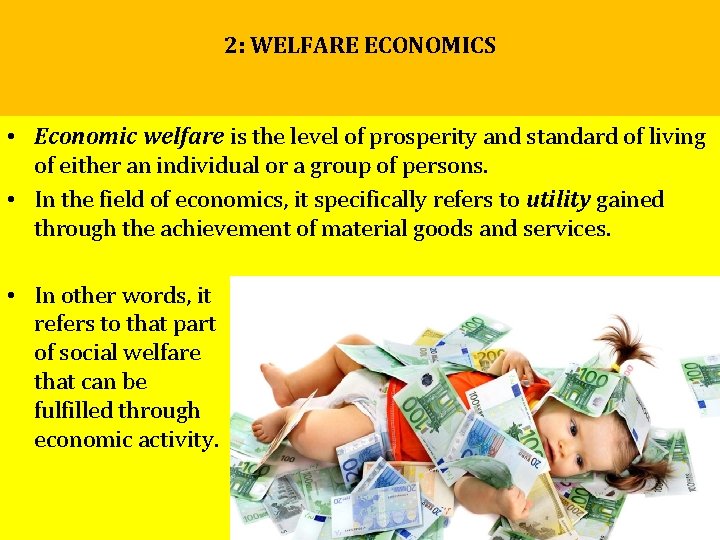
2: WELFARE ECONOMICS • Economic welfare is the level of prosperity and standard of living of either an individual or a group of persons. • In the field of economics, it specifically refers to utility gained through the achievement of material goods and services. • In other words, it refers to that part of social welfare that can be fulfilled through economic activity.

2: WELFARE ECONOMICS • According to Roefie Hueting: welfare is dependent on factors like employment, income distribution, labor conditions, leisure time, production and the scarce possible uses of the environmental functions.
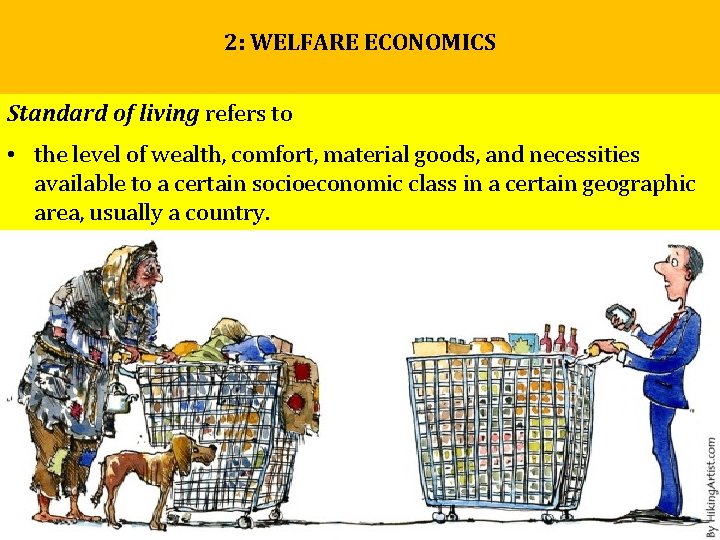
2: WELFARE ECONOMICS Standard of living refers to • the level of wealth, comfort, material goods, and necessities available to a certain socioeconomic class in a certain geographic area, usually a country.
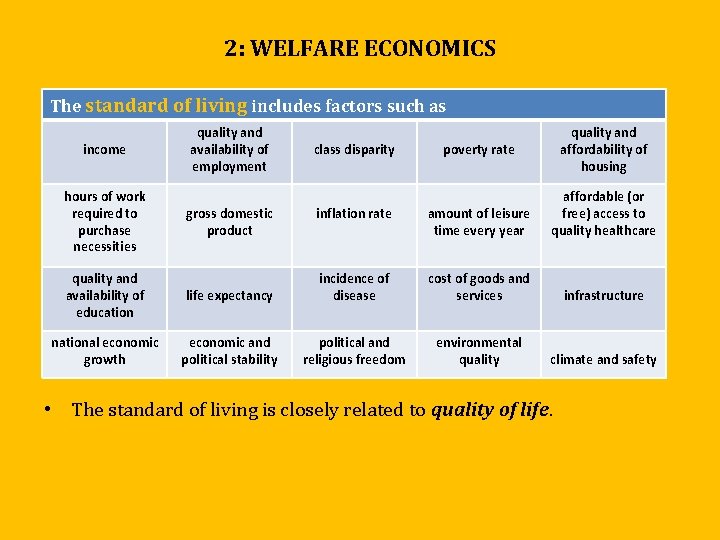
2: WELFARE ECONOMICS The standard of living includes factors such as income hours of work required to purchase necessities quality and availability of employment gross domestic product class disparity quality and affordability of housing poverty rate inflation rate amount of leisure time every year affordable (or free) access to quality healthcare cost of goods and services infrastructure environmental quality climate and safety quality and availability of education life expectancy incidence of disease national economic growth economic and political stability political and religious freedom • The standard of living is closely related to quality of life.
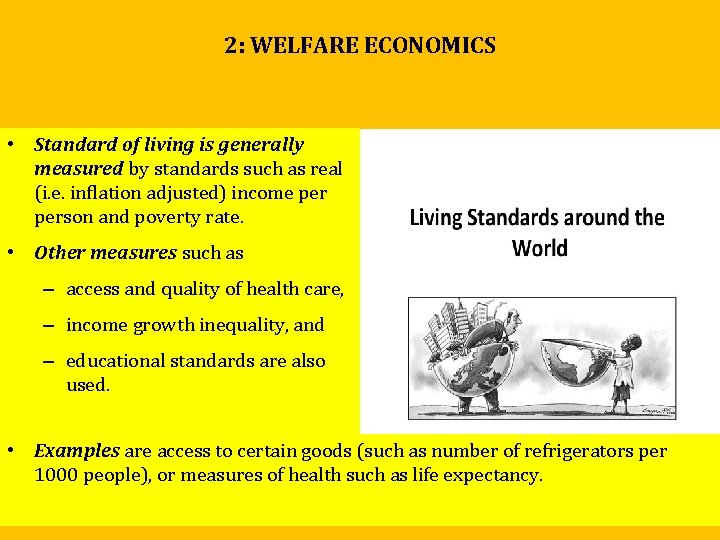
2: WELFARE ECONOMICS • Standard of living is generally measured by standards such as real (i. e. inflation adjusted) income person and poverty rate. • Other measures such as – access and quality of health care, – income growth inequality, and – educational standards are also used. • Examples are access to certain goods (such as number of refrigerators per 1000 people), or measures of health such as life expectancy.

2: WELFARE ECONOMICS • Welfare is the provision of – a minimal level of well-being and – social support for citizens and – other eligible residents without sufficient current means to support basic needs. • In most developed countries, welfare is mainly provided by the – government from tax revenue, and – to a lesser extent by NGOs, charities, informal social groups, religious groups, and intergovernmental organizations.

2: WELFARE ECONOMICS • Welfare can take a variety of forms, such as – monetary payments, – subsidies and vouchers, or – housing assistance. • Welfare systems differ from country to country, but welfare is commonly provided to individuals who are – unemployed, – those with illness or – disability, – the elderly, – those with dependent children, and – veterans.

2: WELFARE ECONOMICS • Welfare is provided by governments or – their organizations, – by private organizations, or – a combination of both. • Funding for welfare usually comes from general government revenue, but when dealing with charities or NGOs, donations may be used. • Some countries run conditional cash transfer welfare programs where payment is conditional on behavior of the recipients.
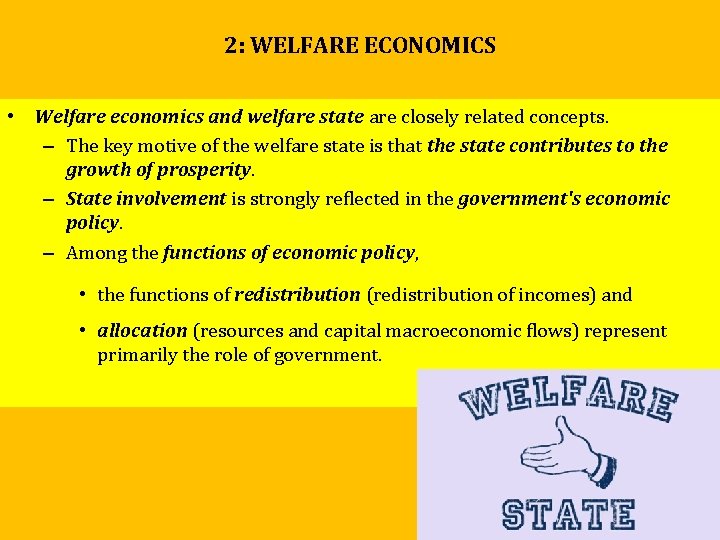
2: WELFARE ECONOMICS • Welfare economics and welfare state are closely related concepts. – The key motive of the welfare state is that the state contributes to the growth of prosperity. – State involvement is strongly reflected in the government's economic policy. – Among the functions of economic policy, • the functions of redistribution (redistribution of incomes) and • allocation (resources and capital macroeconomic flows) represent primarily the role of government.
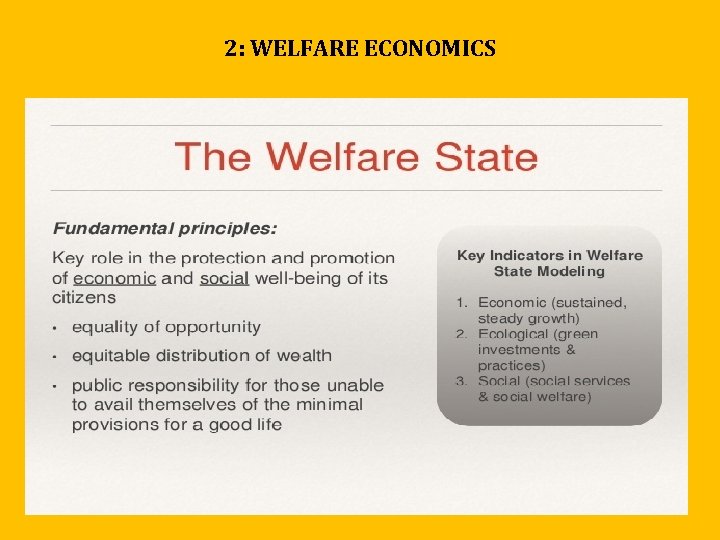
2: WELFARE ECONOMICS

2: WELFARE ECONOMICS • State regulation limits the market mechanism but does not put it down. • Government and businesses strive for partnerships on a contractual basis. • A typical example of the welfare state is Sweden, where, in addition to the developed economy, high social care has been achieved. • Sweden thus became one of the examples of mixed economies. • However, due to various economic problems, social entitlements were reduced in the early 1990 s.
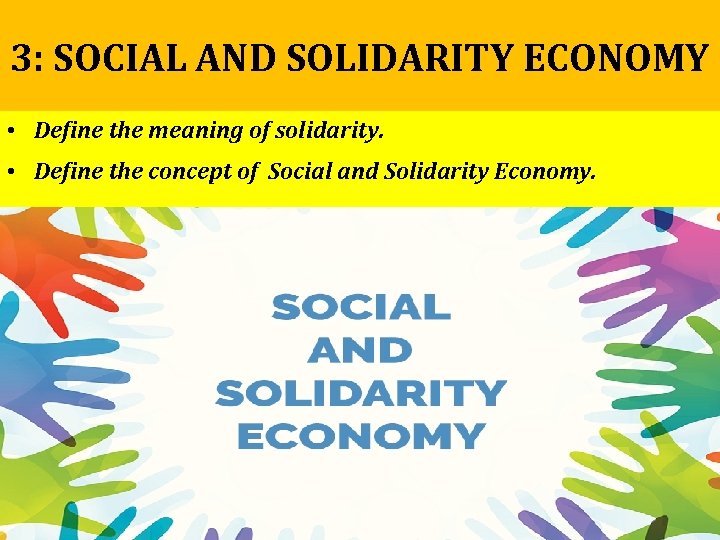
3: SOCIAL AND SOLIDARITY ECONOMY • Define the meaning of solidarity. • Define the concept of Social and Solidarity Economy.
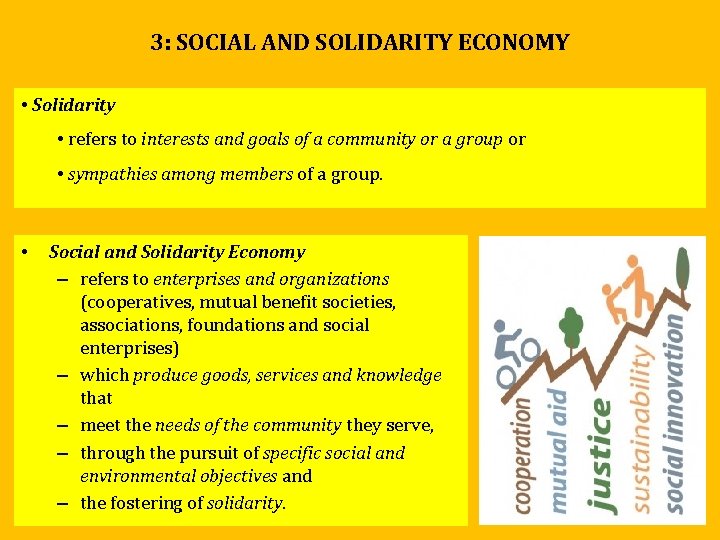
3: SOCIAL AND SOLIDARITY ECONOMY • Solidarity • refers to interests and goals of a community or a group or • sympathies among members of a group. • Social and Solidarity Economy – refers to enterprises and organizations (cooperatives, mutual benefit societies, associations, foundations and social enterprises) – which produce goods, services and knowledge that – meet the needs of the community they serve, – through the pursuit of specific social and environmental objectives and – the fostering of solidarity.

3: SOCIAL AND SOLIDARITY ECONOMY PROBLEMS, PHENOMENA AND PROCESSES UNDERLYING THE CONSOLIDATION OF SOCIAL ECONOMY • One of the greatest challenges of the XXI. century is the decreasing of labour demand: – the number and proportion of employed people living in the "developed world” decreased since the 1970’s; – at the same time the number of unemployed people has increased. • Social economy is a fast-developing achievement of the European economic and social space. • Its recent uptrend relates to two problems: – the growing demand for social, personal and public services, and – the search for ways and means to satisfy the relevant needs cheaply, in a context characterised by budgetary restrictions and tax cuts.
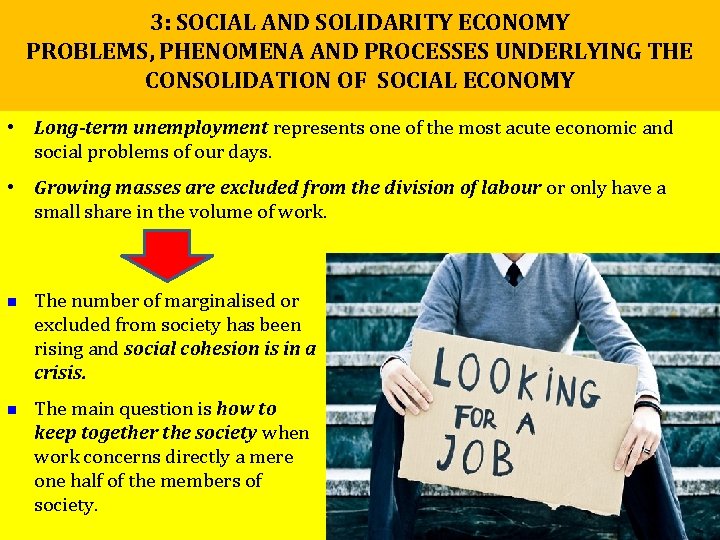
3: SOCIAL AND SOLIDARITY ECONOMY PROBLEMS, PHENOMENA AND PROCESSES UNDERLYING THE CONSOLIDATION OF SOCIAL ECONOMY • Long-term unemployment represents one of the most acute economic and social problems of our days. • Growing masses are excluded from the division of labour or only have a small share in the volume of work. n n The number of marginalised or excluded from society has been rising and social cohesion is in a crisis. The main question is how to keep together the society when work concerns directly a mere one half of the members of society.
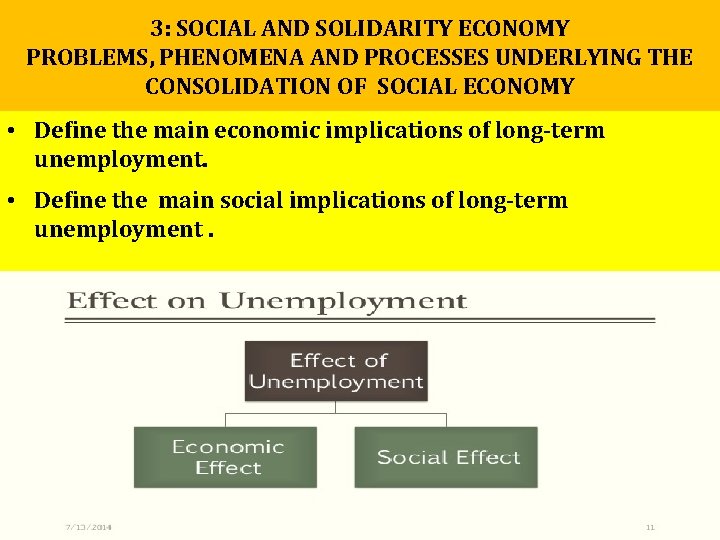
3: SOCIAL AND SOLIDARITY ECONOMY PROBLEMS, PHENOMENA AND PROCESSES UNDERLYING THE CONSOLIDATION OF SOCIAL ECONOMY • Define the main economic implications of long-term unemployment. • Define the main social implications of long-term unemployment.
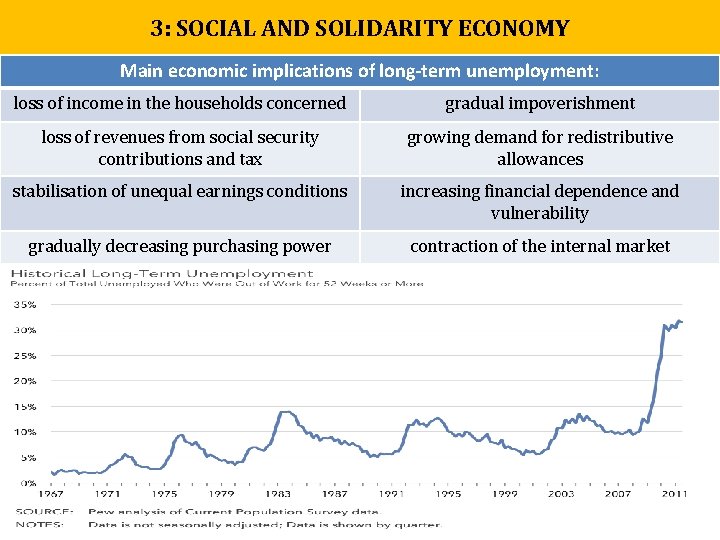
3: SOCIAL AND SOLIDARITY ECONOMY Main economic implications of long-term unemployment: loss of income in the households concerned gradual impoverishment loss of revenues from social security contributions and tax growing demand for redistributive allowances stabilisation of unequal earnings conditions increasing financial dependence and vulnerability gradually decreasing purchasing power contraction of the internal market
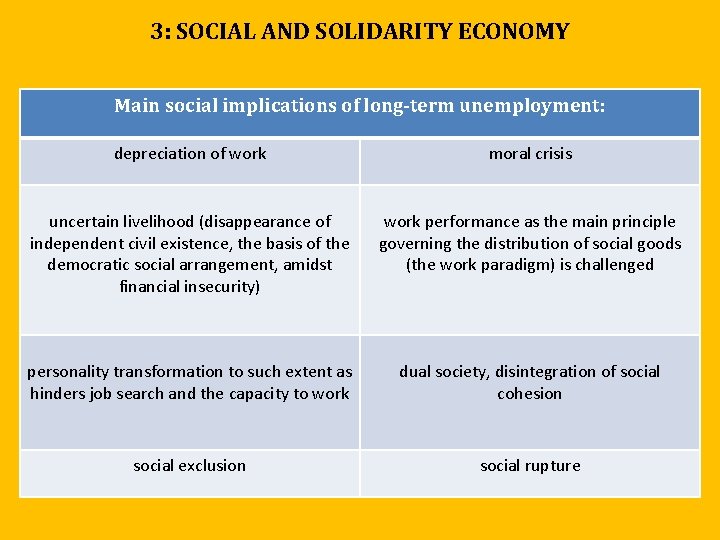
3: SOCIAL AND SOLIDARITY ECONOMY Main social implications of long-term unemployment: depreciation of work moral crisis uncertain livelihood (disappearance of independent civil existence, the basis of the democratic social arrangement, amidst financial insecurity) work performance as the main principle governing the distribution of social goods (the work paradigm) is challenged personality transformation to such extent as hinders job search and the capacity to work dual society, disintegration of social cohesion social exclusion social rupture

3: SOCIAL AND SOLIDARITY ECONOMY PROBLEMS, PHENOMENA AND PROCESSES UNDERLYING THE CONSOLIDATION OF SOCIAL ECONOMY • Because high level of unemployment in Western Europe in the second half of the 1990 s, and • the incapacity of the formal economy • needed to create a sufficient number of jobs to absorb and to provide for the placement of persons at a disadvantage.
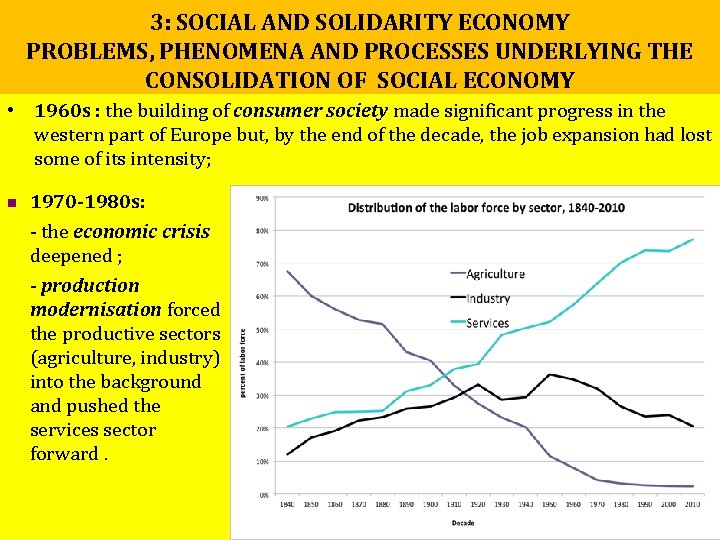
3: SOCIAL AND SOLIDARITY ECONOMY PROBLEMS, PHENOMENA AND PROCESSES UNDERLYING THE CONSOLIDATION OF SOCIAL ECONOMY • 1960 s : the building of consumer society made significant progress in the western part of Europe but, by the end of the decade, the job expansion had lost some of its intensity; n 1970 -1980 s: - the economic crisis deepened ; - production modernisation forced the productive sectors (agriculture, industry) into the background and pushed the services sector forward.

3: SOCIAL AND SOLIDARITY ECONOMY PROBLEMS, PHENOMENA AND PROCESSES UNDERLYING THE CONSOLIDATION OF SOCIAL ECONOMY • The key instrument of the management of structural unemployment of former agricultural and rural workers was the extended and re-organised training system; • which was meant to channel the workers from the obsolete branches to the new, dynamically developing ones; n „omnipotence” of training: n it was generally accepted that every labour market problem could be solved by training services.

3: SOCIAL AND SOLIDARITY ECONOMY PROBLEMS, PHENOMENA AND PROCESSES UNDERLYING THE CONSOLIDATION OF SOCIAL ECONOMY • 1980 s : globalisation, technological modernisation and sectoral restructuring reduced the volume of work to such an extent as led to the permanent and extensive exclusion of workers from the labour market; n n Consequently, employees in a poor labour market position were excluded not only from work, but from social reproduction as well. The reproduction of physical and social existence in these social groups had become a permanent and extensive task of the welfare systems.
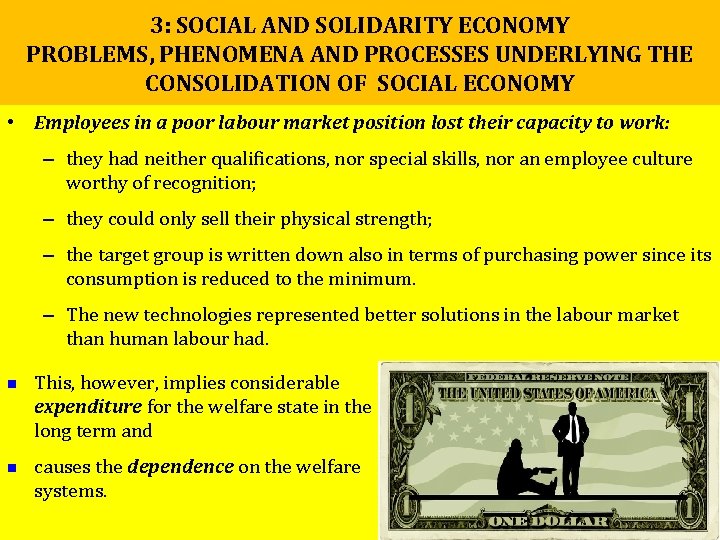
3: SOCIAL AND SOLIDARITY ECONOMY PROBLEMS, PHENOMENA AND PROCESSES UNDERLYING THE CONSOLIDATION OF SOCIAL ECONOMY • Employees in a poor labour market position lost their capacity to work: – they had neither qualifications, nor special skills, nor an employee culture worthy of recognition; – they could only sell their physical strength; – the target group is written down also in terms of purchasing power since its consumption is reduced to the minimum. – The new technologies represented better solutions in the labour market than human labour had. n n This, however, implies considerable expenditure for the welfare state in the long term and causes the dependence on the welfare systems.
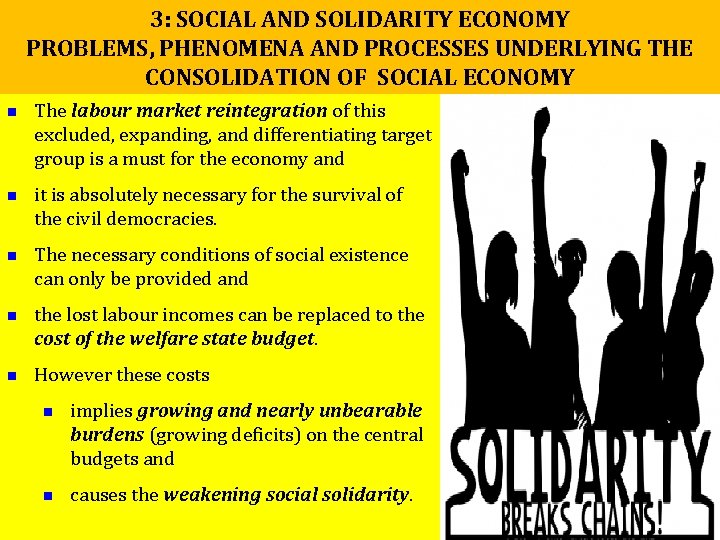
3: SOCIAL AND SOLIDARITY ECONOMY PROBLEMS, PHENOMENA AND PROCESSES UNDERLYING THE CONSOLIDATION OF SOCIAL ECONOMY n n n The labour market reintegration of this excluded, expanding, and differentiating target group is a must for the economy and it is absolutely necessary for the survival of the civil democracies. The necessary conditions of social existence can only be provided and the lost labour incomes can be replaced to the cost of the welfare state budget. However these costs n n implies growing and nearly unbearable burdens (growing deficits) on the central budgets and causes the weakening social solidarity.
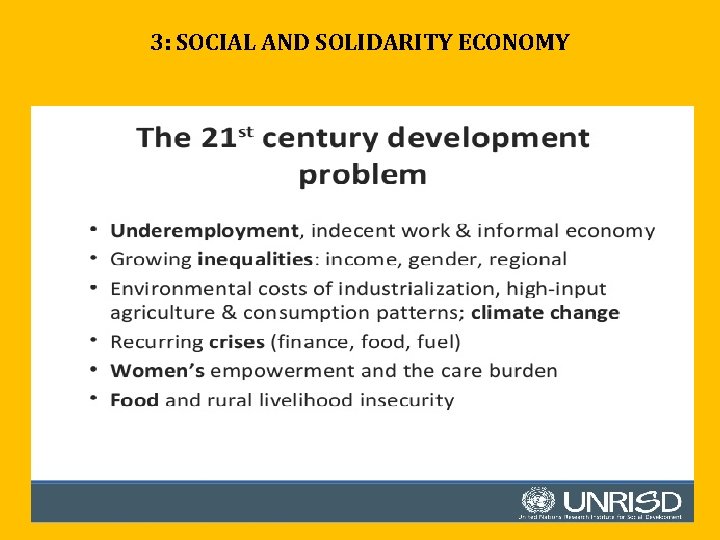
3: SOCIAL AND SOLIDARITY ECONOMY
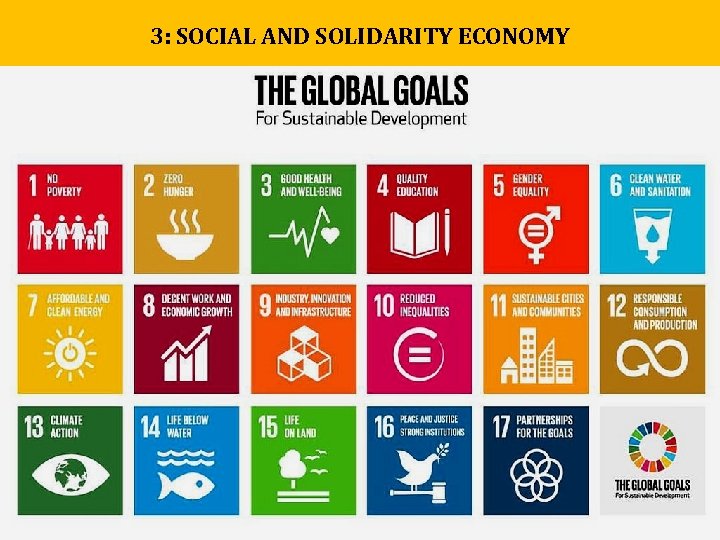
3: SOCIAL AND SOLIDARITY ECONOMY
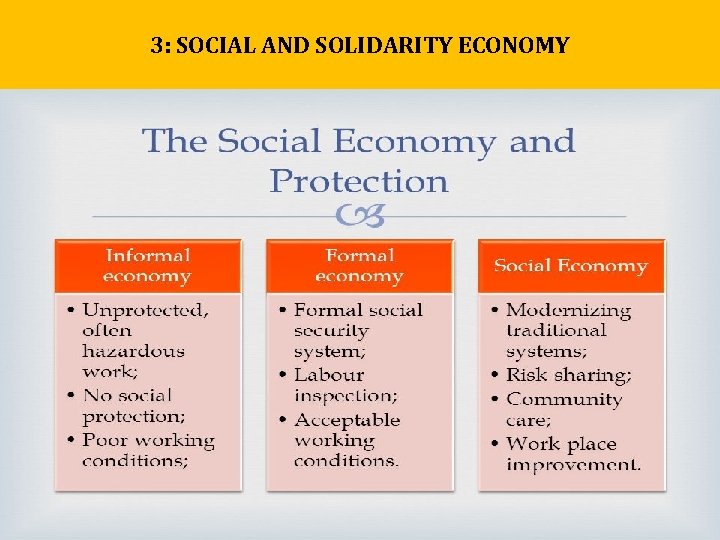
3: SOCIAL AND SOLIDARITY ECONOMY
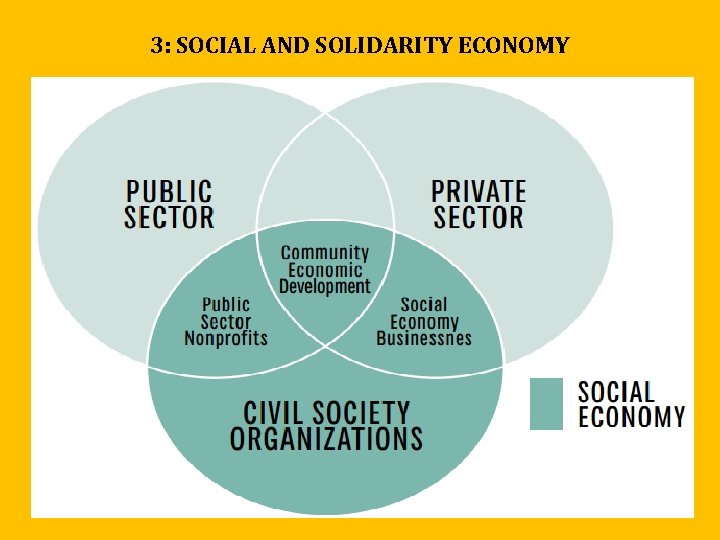
3: SOCIAL AND SOLIDARITY ECONOMY
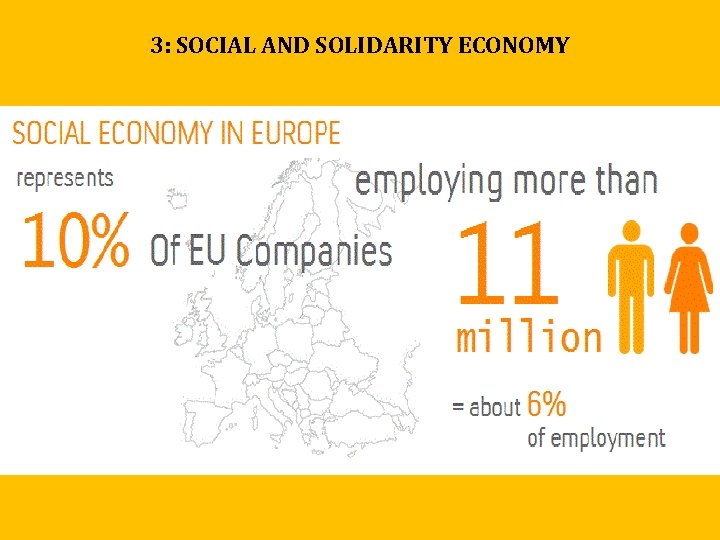
3: SOCIAL AND SOLIDARITY ECONOMY
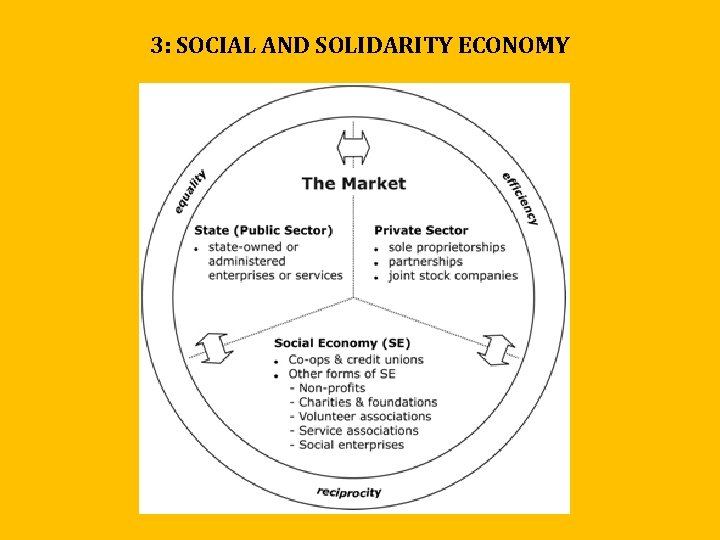
3: SOCIAL AND SOLIDARITY ECONOMY
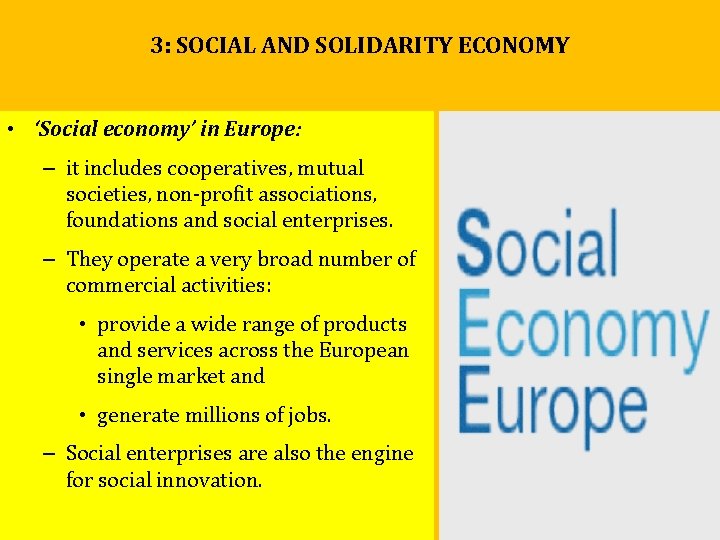
3: SOCIAL AND SOLIDARITY ECONOMY • ‘Social economy’ in Europe: – it includes cooperatives, mutual societies, non-profit associations, foundations and social enterprises. – They operate a very broad number of commercial activities: • provide a wide range of products and services across the European single market and • generate millions of jobs. – Social enterprises are also the engine for social innovation.

3: SOCIAL AND SOLIDARITY ECONOMY • Enterprises of social economy in Europe are important because of their: – membership: up to 160 million people in Europe are members of social economy enterprises (mostly retail, banking and agricultural cooperatives, as well as mutual societies offering services complementary to social security regimes); – objectives: enterprises of social economy contribute to the EU’s employment, social cohesion, regional and rural development, environmental protection, consumer protection, agricultural, third countries development, and social security policies; – size: social economy entities are mostly micro, small, and medium-sized enterprises (SMEs).
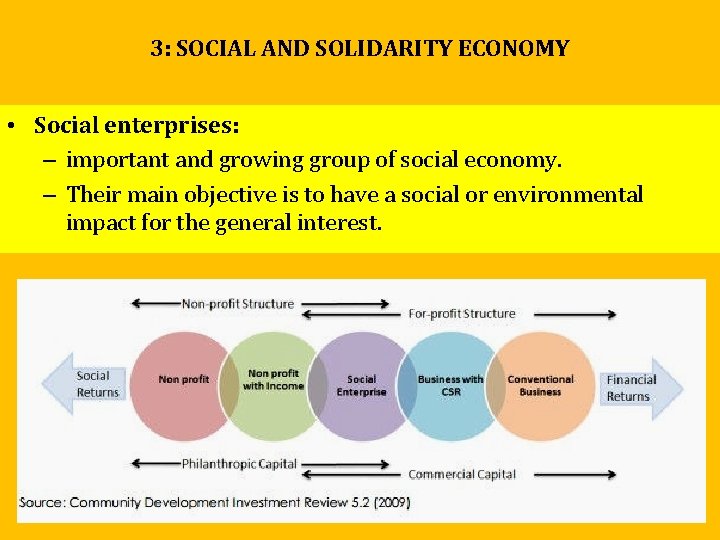
3: SOCIAL AND SOLIDARITY ECONOMY • Social enterprises: – important and growing group of social economy. – Their main objective is to have a social or environmental impact for the general interest.
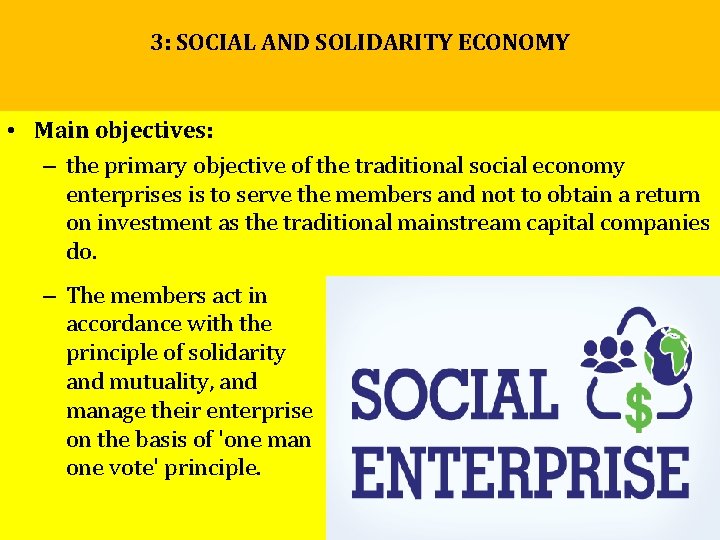
3: SOCIAL AND SOLIDARITY ECONOMY • Main objectives: – the primary objective of the traditional social economy enterprises is to serve the members and not to obtain a return on investment as the traditional mainstream capital companies do. – The members act in accordance with the principle of solidarity and mutuality, and manage their enterprise on the basis of 'one man one vote' principle.
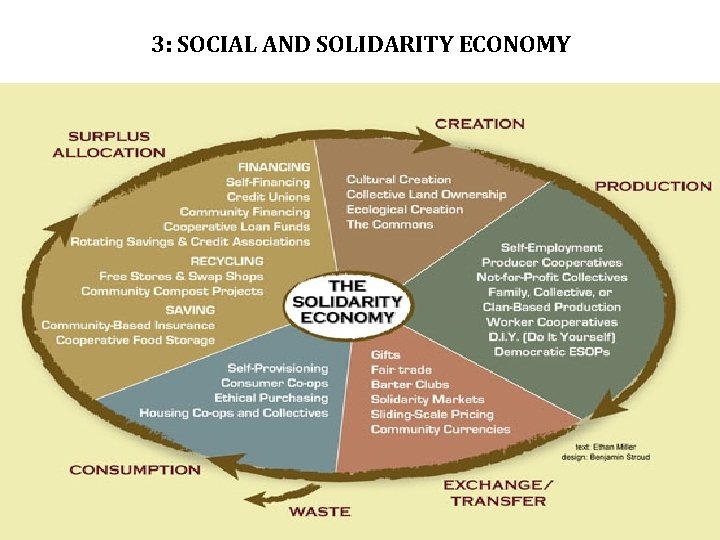
3: SOCIAL AND SOLIDARITY ECONOMY
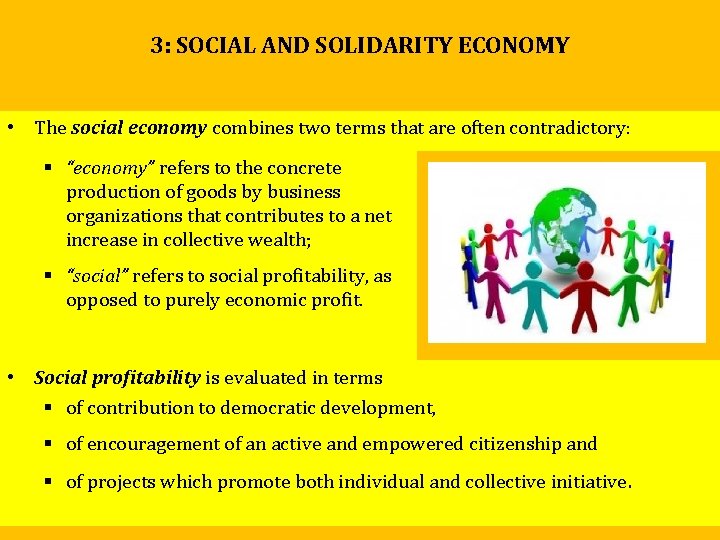
3: SOCIAL AND SOLIDARITY ECONOMY • The social economy combines two terms that are often contradictory: § “economy” refers to the concrete production of goods by business organizations that contributes to a net increase in collective wealth; § “social” refers to social profitability, as opposed to purely economic profit. • Social profitability is evaluated in terms § of contribution to democratic development, § of encouragement of an active and empowered citizenship and § of projects which promote both individual and collective initiative.
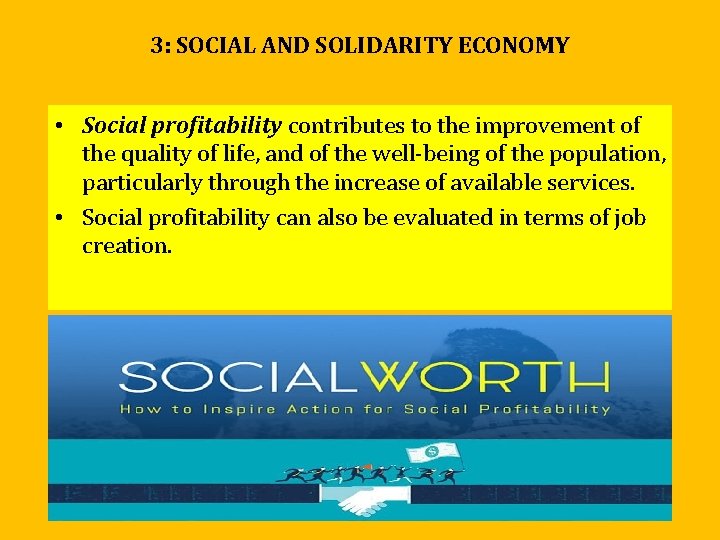
3: SOCIAL AND SOLIDARITY ECONOMY • Social profitability contributes to the improvement of the quality of life, and of the well-being of the population, particularly through the increase of available services. • Social profitability can also be evaluated in terms of job creation.
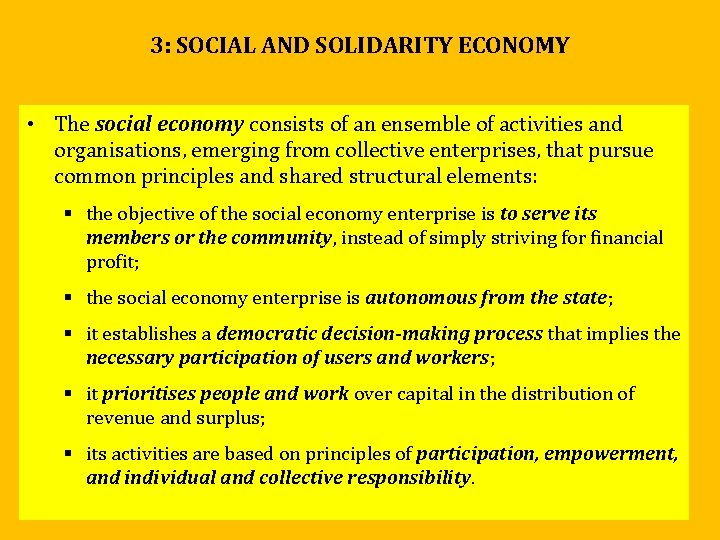
3: SOCIAL AND SOLIDARITY ECONOMY • The social economy consists of an ensemble of activities and organisations, emerging from collective enterprises, that pursue common principles and shared structural elements: § the objective of the social economy enterprise is to serve its members or the community, instead of simply striving for financial profit; § the social economy enterprise is autonomous from the state; § it establishes a democratic decision-making process that implies the necessary participation of users and workers; § it prioritises people and work over capital in the distribution of revenue and surplus; § its activities are based on principles of participation, empowerment, and individual and collective responsibility.
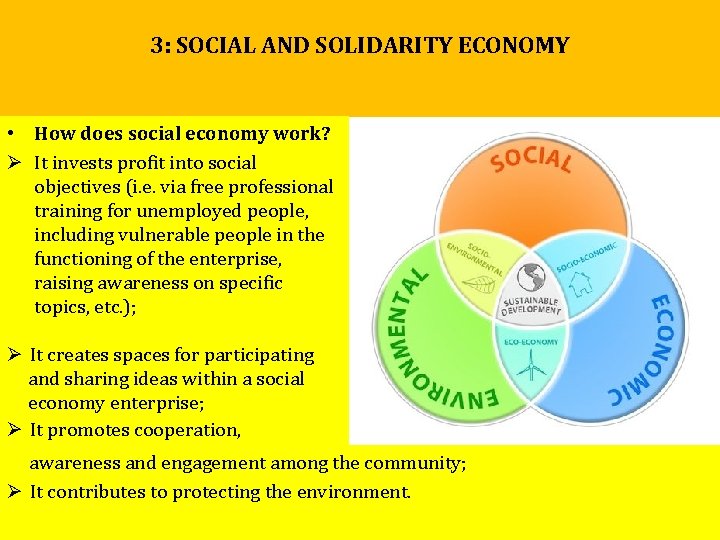
3: SOCIAL AND SOLIDARITY ECONOMY • How does social economy work? Ø It invests profit into social objectives (i. e. via free professional training for unemployed people, including vulnerable people in the functioning of the enterprise, raising awareness on specific topics, etc. ); Ø It creates spaces for participating and sharing ideas within a social economy enterprise; Ø It promotes cooperation, awareness and engagement among the community; Ø It contributes to protecting the environment.
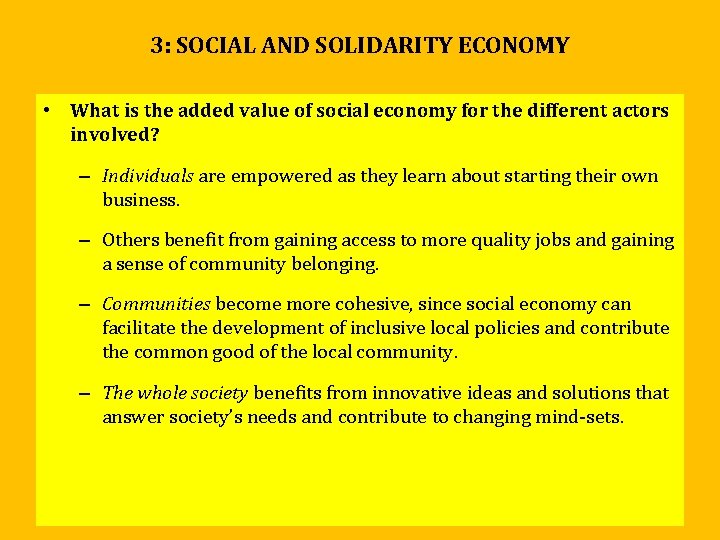
3: SOCIAL AND SOLIDARITY ECONOMY • What is the added value of social economy for the different actors involved? – Individuals are empowered as they learn about starting their own business. – Others benefit from gaining access to more quality jobs and gaining a sense of community belonging. – Communities become more cohesive, since social economy can facilitate the development of inclusive local policies and contribute the common good of the local community. – The whole society benefits from innovative ideas and solutions that answer society’s needs and contribute to changing mind-sets.
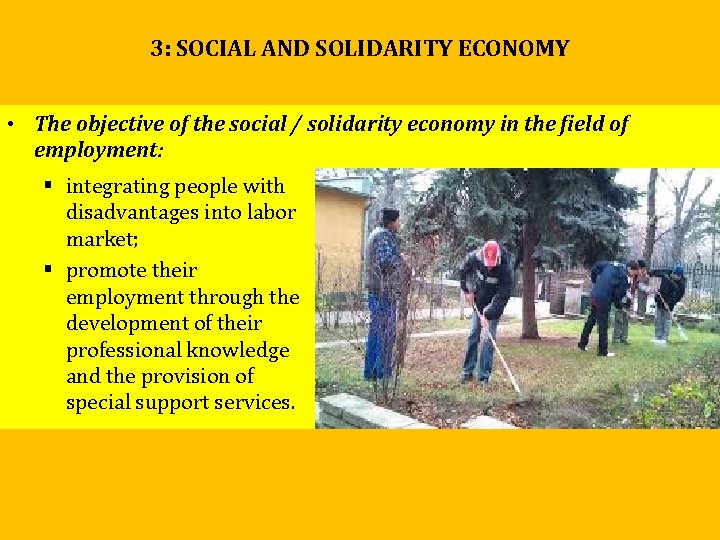
3: SOCIAL AND SOLIDARITY ECONOMY • The objective of the social / solidarity economy in the field of employment: § integrating people with disadvantages into labor market; § promote their employment through the development of their professional knowledge and the provision of special support services.
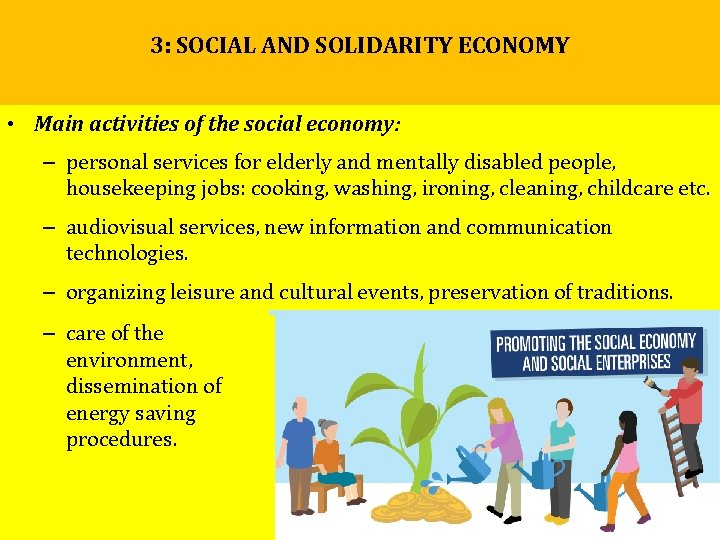
3: SOCIAL AND SOLIDARITY ECONOMY • Main activities of the social economy: – personal services for elderly and mentally disabled people, housekeeping jobs: cooking, washing, ironing, cleaning, childcare etc. – audiovisual services, new information and communication technologies. – organizing leisure and cultural events, preservation of traditions. – care of the environment, dissemination of energy saving procedures.
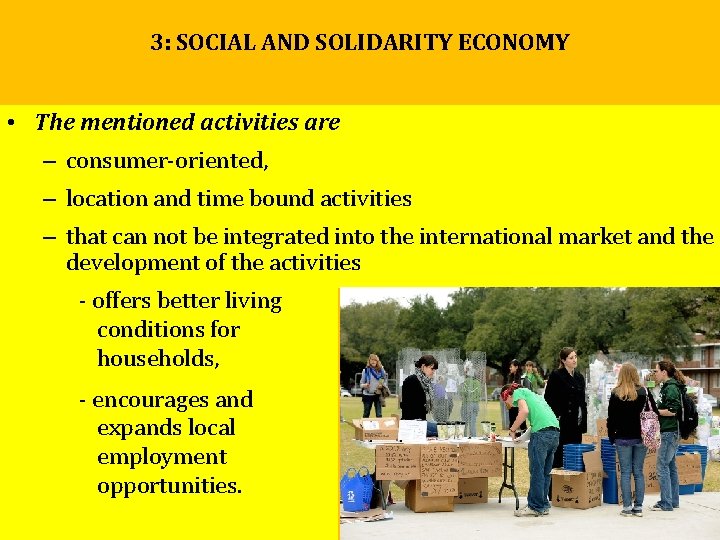
3: SOCIAL AND SOLIDARITY ECONOMY • The mentioned activities are – consumer-oriented, – location and time bound activities – that can not be integrated into the international market and the development of the activities - offers better living conditions for households, - encourages and expands local employment opportunities.

3: SOCIAL AND SOLIDARITY ECONOMY • Target groups of social / solidarity economic activities in the field of employment: long-term unemployed people, entrant young people, mothers with small children, elderly people, handicapped people, people with a low level of education, § people with social disabilities. § § §

3: SOCIAL AND SOLIDARITY ECONOMY • Organizations of social economy also play an essential social integration function besides their economic performance.
- Slides: 157